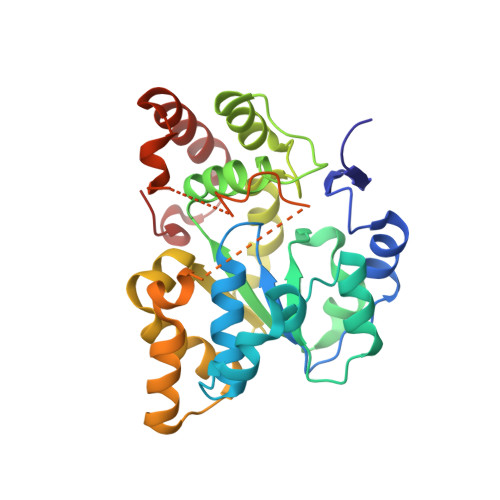Identification and characterization of two amino acids critical for the substrate inhibition of human dehydroepiandrosterone sulfotransferase (SULT2A1)
Lu, L.Y., Hsieh, Y.C., Liu, M.Y., Lin, Y.H., Chen, C.J., Yang, Y.S.(2008) Mol Pharmacol 73: 660-668
- PubMed: 18042734
- DOI: https://doi.org/10.1124/mol.107.041038
- Primary Citation of Related Structures:
2QP3, 2QP4 - PubMed Abstract:
Substrate inhibition is a characteristic feature of many cytosolic sulfotransferases. The differences between the complex structures of SULT2A1/DHEA and SULT2A1/PAP or SULT2A1/ADT (Protein Data Bank codes are 1J99, 1EFH, and 1OV4, respectively) have enabled us to elucidate the specific amino acids responsible for substrate inhibition. Based on the structural analyses, substitution of the smaller residue alanine for Tyr-238 (Y238A) significantly increases the K(i) value for dehydroepiandrosterone (DHEA) and totally eliminates substrate inhibition for androsterone (ADT). In addition, Met-137 was proposed to regulate the binding orientations of DHEA and ADT in SULT2A1. Complete elimination or regeneration of substrate inhibition for SULT2A1 with DHEA or ADT as substrate, respectively, was demonstrated with the mutations of Met-137 on Y238A mutant. Analysis of the Met-137 mutants and Met-137/Tyr-238 double mutants uncovered the relationship between substrate binding orientations and inhibition in SULT2A1. Our data indicate that, in the substrate inhibition mode, Tyr-238 regulates the release of bound substrate, and Met-137 controls substrate binding orientation of DHEA and ADT in SULT2A1. The proposed substrate inhibition mechanism is further confirmed by the crystal structures of SULT2A1 mutants at Met-137. We propose that both substrate binding orientations exhibited substrate inhibition. In addition, a corresponding residue in other cytosolic sulfotransferases was shown to have a function similar to that of Tyr-238 in SULT2A1.
Organizational Affiliation:
Department of Biological Science and Technology, National Chiao Tung University, Hsinchu, Taiwan, ROC, 75 Po-Ai Street, Hsinchu30050, Taiwan, ROC. ysyang@faculty.nctu.edu.tw















